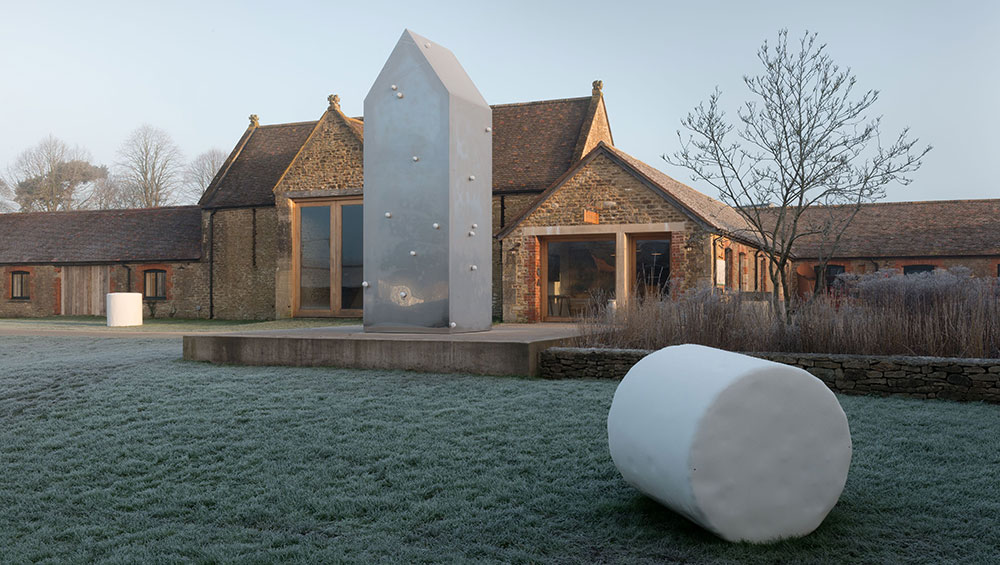
Installation view, Not Vital. SCARCH’ Hauser & Wirth Somerset 2020. Photo: Ken Adlard. Courtesy of the artist and Hauser & Wirth © Not Vital.
Hauser & Wirth, Somerset
25 January - 4 May 2020
by VERONICA SIMPSON
For a globetrotting artist in his 70s, with sculptures – not to mention homes and studios – scattered across every continent, Not Vital (b1948, Switzerland) has taken his time to reveal his talents to the UK. His first major solo show was three years ago (May 2016 to January 2017) at the Yorkshire Sculpture Park. It is good to see his compelling sensibility – restlessly exploring the connections between interior and exterior space, between the material and the imaginary - given another outing. And particularly pleasurable to see them in the rustic-chic galleries of Hauser & Wirth, Somerset; his voluptuous forms and shiny surfaces look splendid set against the gently undulating, Somerset landscape. You could say it was the perfect setting for a show dedicated to his particular combination of architecture and sculpture, which he has dubbed: “SCARCH” - though I wouldn’t mind seeing them at his home in Sent, in Switzerland’s remote Engadine valley, whose monochrome palette (snow or black rock) and jagged skyline clearly imprinted themselves indelibly on the young Vital.
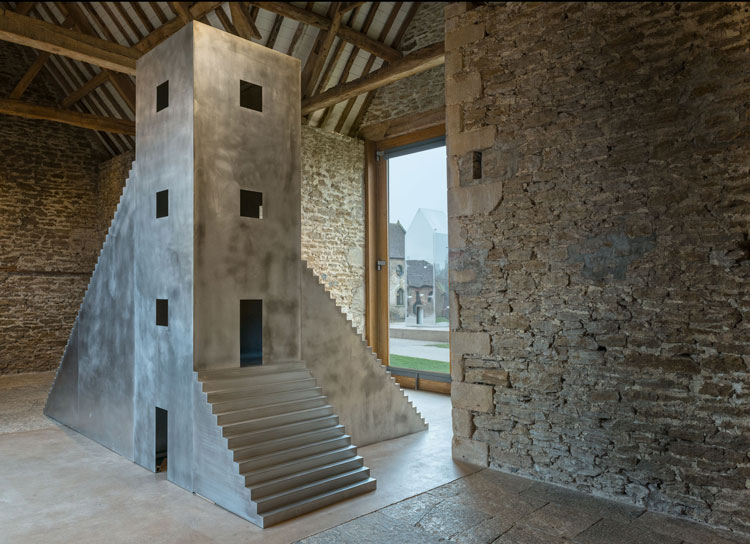
Not Vital. House to Watch the Sunset, 2005. Aluminium, 430 x 550 x 330 cm (169 1/4 x 216 1/2 x 129 7/8 in). Installation view, Not Vital. SCARCH’ Hauser & Wirth Somerset 2020. Photo: Ken Adlard. Courtesy of the artist and Hauser & Wirth © Not Vital.
The lofty, triple-height, gnarled wooden roof beams and crumbling stone walls of the Threshing Barn gallery form a rich backdrop for Vital’s House to Watch the Sunset (2005); its aluminium surfaces glimmer like a throne in here. This is a scaled-down recreation of a tower he first constructed out of mud in Agadez, Niger, for one purpose only: to see the sun set over the surrounding palm trees. The only way of building the slender walls up to the height he wanted was by propping them up on three sides with steps; three perfectly chiselled staircases ascend at different scales in specific increments of 13, up to their unique doorways (the original house is three, discrete storeys, reachable only by their specific doors).
-1-Ken-Adlard.jpg)
Not Vital. House to Watch the Sunset, 2005. Aluminium, 430 x 550 x 330 cm (169 1/4 x 216 1/2 x 129 7/8 in). Installation view, Not Vital. SCARCH’ Hauser & Wirth Somerset 2020. Photo: Ken Adlard. Courtesy of the artist and Hauser & Wirth © Not Vital.
Apparently, this solution so pleased him in its purity – “You can’t add anything or subtract,” he says – that he decided to create one on every continent, using local skilled artisans and site-specific materials. There is already a wooden one in the Amazon, and one made of metal in Mongolia. He will be producing another in Venice, this summer, for the architecture biennale, on the island of San Giorgio Maggiore (where, in 2013, he showed his 700 Snowballs, made of semi-opaque Murano glass).
Is there another living artist who has reimagined what architecture is or does quite so comprehensively as Vital? His restless, nomadic existence has allowed him to create and recreate structures, both habitable and not habitable, all over the world. He currently has homes and studios in Niger (Agadiz), Rio and Beijing as well as several in Sent, including the recently purchased 11th-century Tarasp Castle, the interiors of which he is resculpting as a display space and archive for his works.
.jpg)
Not Vital. 100 Architects, 2016. Black granite, dimensions variable, average height 56.22 cm. Installation view, Not Vital. SCARCH’ Hauser & Wirth Somerset 2020. Photo: Ken Adlard. Courtesy of the artist and Hauser & Wirth © Not Vital.
In this show, he has even reimagined what an architect is. Literally. The work 100 Architects (2016) is a processional, memorial-esque display of black granite towers, sited along either wall of the Workshop gallery. Each one is a portrait of a specific architect, rendered into definitive shapes by their birth date, and some of which – he tells us on our pre-opening tour – we may be able to guess by the shape. His formula translates the head by the day, the shoulders by the month and the torso by the year of their birth. He suggests we try to guess who is who, and then, with a mischievous grin, introduces us to Norman Foster, whose head is tiny, especially compared to his huge, elongated trunk (he was born on 1 June 1935).
In conversation, it is clear that serendipity and spontaneity are at the heart of Vital’s process, although his schedule is surprisingly rigorous: he dedicates one specific activity to a particular region. China is where he makes sculptures, whereas Rio is where he draws. The constraints arising from this arrangement seem to inspire greater improvisation. For example, he tells us the only art supplier in Rio closed down recently, so he has had to find materials for sketching where he can.
.jpg)
Installation view, Not Vital. SCARCH’ Hauser & Wirth Somerset 2020. Photo: Ken Adlard. Courtesy of the artist and Hauser & Wirth © Not Vital.
The results of this are displayed in the next two galleries, the thick, limewashed walls of which are lined in his “sculptures on paper”. These are light, playful and elemental. They lack the visceral intensity of his paintings – the YSP show featured a selection of his spectral portraits with their dense, black heads – but more than make up for it with the improvisatory, almost kinetic flair with which he articulates the outline or spirit of a building with some cotton buds, or sheets of stickers.
.jpg)
Not Vital. Synagogue for Tel Aviv, 2010. Straws, tape and pencil on paper, 43.2 x 35.6 cm (17 x 14 in). Image © Not Vital. Courtesy of the artist and Hauser & Wirth.
Here we have a house drawn in dental floss. There we find two whitish, lumpen structures - collapsing coffee filters – intended to represent his journey to Ulan Bator; presumably they are meant to be tents. The materials he uses exude their own essential qualities, yet hint, excitingly, at the material properties of a building yet to come. A stack of clustered, luminous green, drinking straws - his Synagogue for Tel Aviv (2010) - worked particularly well, I thought, to conjure a tower of rippling, lime-tinted light. His materials and structures are chosen to respond specifically to the qualities of a place – even their name, it seems, such as the tower he proposes for Uppsala, sketched in pink drinking straws, still sheathed in their thin, paper tubes.
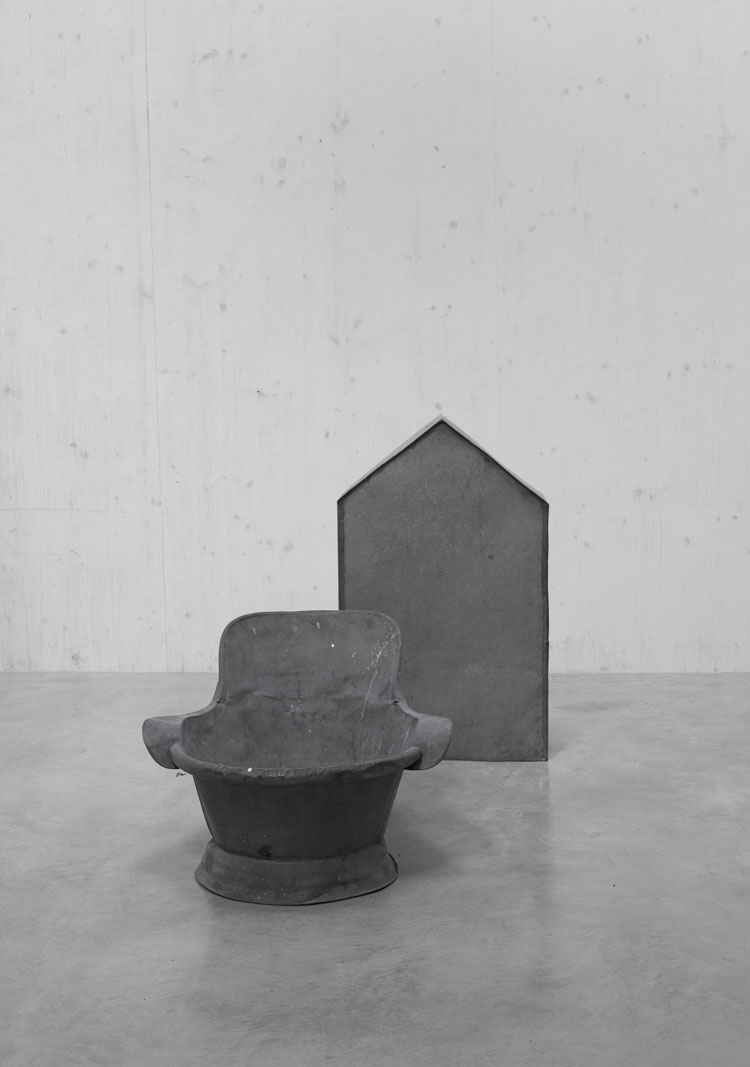
Not Vital. Chasa i Bogn, 1970. Tin
House: 100 x 61 x 24 cm. Bathtub: 53 x 80 x 72.5 cm. Image © Not Vital. Courtesy of the artist and Hauser & Wirth. Photo: Joschi Herzceg.
Placed nearby are some of his earliest works, which testify to Vital’s enduring interest in the concepts of home and habitat, as well as his use of the readymade. Chasa I bogn (1970) offers us a child’s tin bathtub paired with a small, simplified house-shaped structure in the same material. We also have Chanala da tet (1964): a section of roof guttering that he apparently picked up in the street outside his parents’ house. He painted it white.
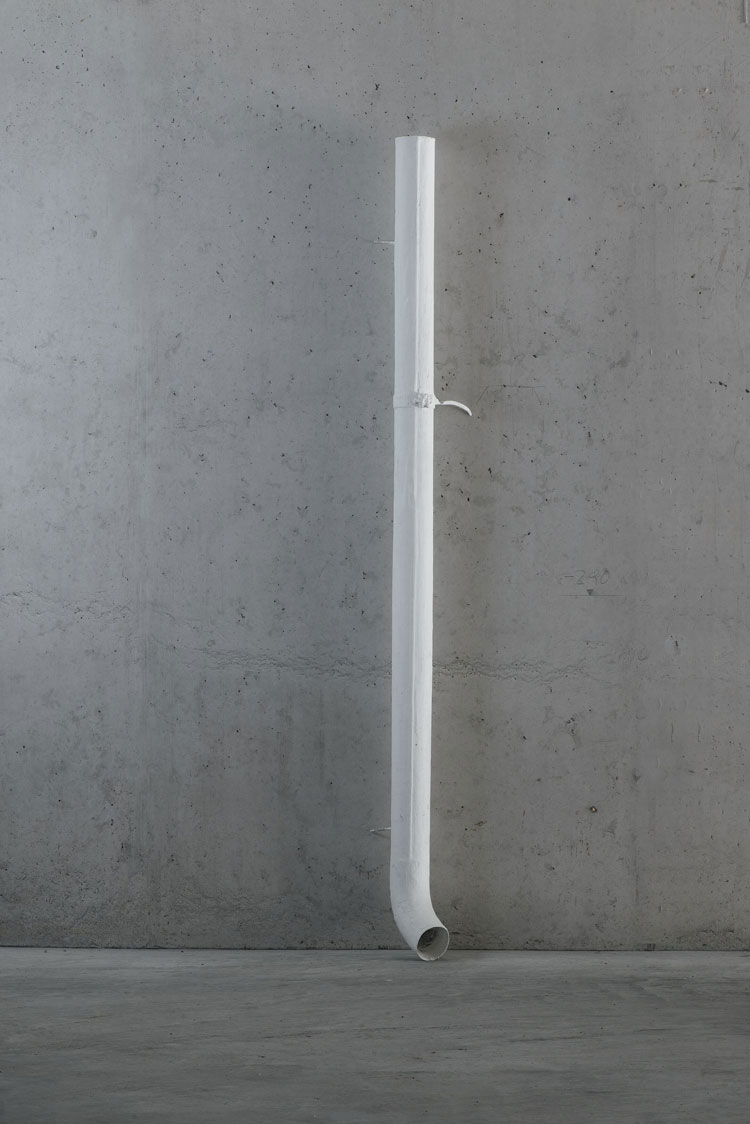
Not Vital. Chanala da tet, 1964. Tin and white paint, 218 x 13 x 21 cm (85 7/8 x 5 1/8 x 8 1/4 in). Image © Not Vital. Courtesy of the artist and Hauser & Wirth. Photo: Joschi Herzceg.
For this show, Hauser & Wirth commissioned a new work, another tower, that gleams in the entrance courtyard, its gently bulging stainless-steel planes turning the honey-coloured stone of the surrounding farm buildings into a comical parody of themselves, like in a circus House of Mirrors, as you walk around it. Cannot Enter Cannot Exit (2020) is pimpled with ceramic “snow bolts”, while its inhumanly small apertures and dimensions repel any human visitor (though it would be interesting to see if any Somerset creatures take up residence there during the show). At just over five metres high, it was designed to mimic the height of Michelangelo’s David. Dotted around the courtyard are several iterations of another work: Bale (2018). These white monuments to agricultural production have been sculpted in steel and cloaked in white varnish.
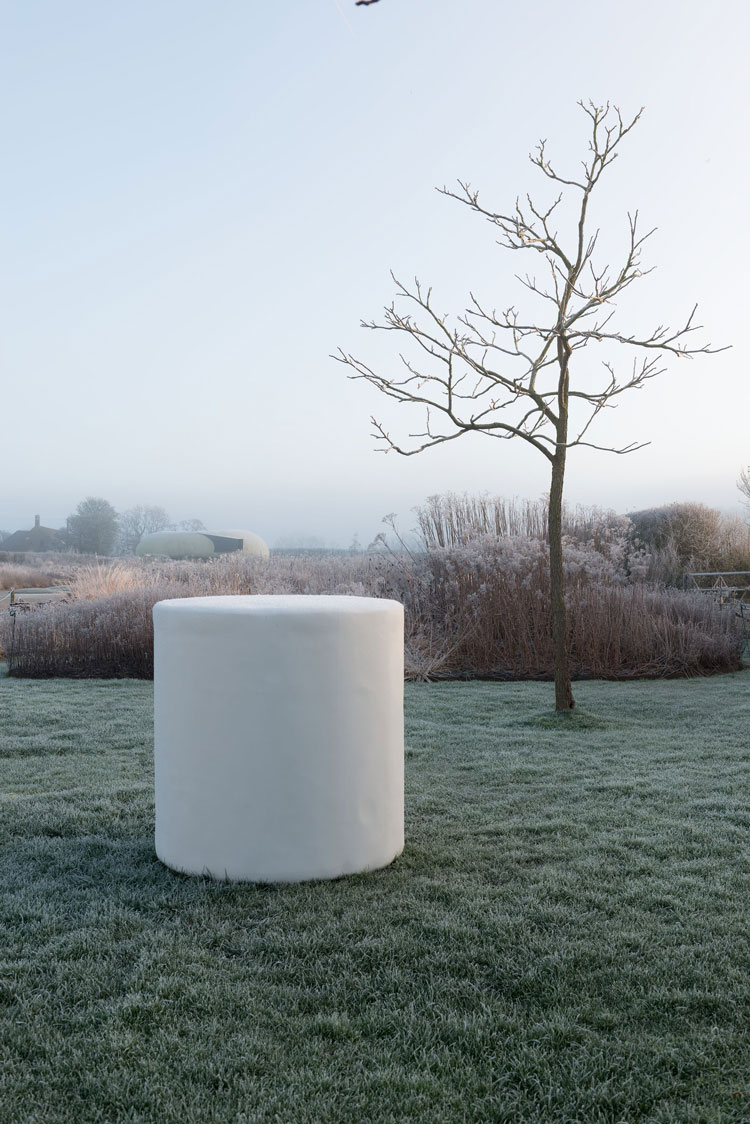
Not Vital. Bale, 2018. Stainless steel with white varnish, 120 x 118 x 118 cm (47 1/4 x 46 1/2 x 46 1/2 in). Installation view, Not Vital. SCARCH’ Hauser & Wirth Somerset 2020. Photo: Ken Adlard. Courtesy of the artist and Hauser & Wirth © Not Vital.
The last exterior work, Date (2016) stands in the inner Cloister Courtyard, a nice counterpoint to Franz West’s two white masks currently placed nearby. This full-bodied, fruit-shaped, steel sculpture is peeled open so you can glimpse its glossy, dimpled interior and even creep inside it.
Vital was described by Andrew O’Hagan in the New York Times in 2013 as: “The Picasso of today – driving a herd of symbolic bulls through the gardens of convention and changing our idea of how to see.” I wouldn’t disagree. But I would add that, for a man named Not Vital, he has done everything in his power to prove the opposite.